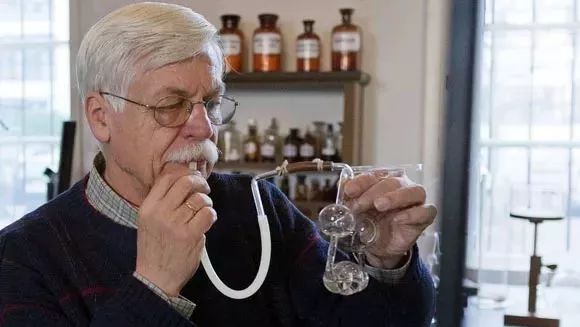
No, this is not a hookah.
A glass tube bent into a triangle with five balls on it. What is this?
in fact, it is a classic chemical analytical instrument in history.
the device is called "Kaliapparat" (German for caustic potassium apparatus, Chinese can be called potash ball), which was invented by German chemist Justus von Liebich in 1831. The purpose of this thing is to analyze the carbon content of organic matter.
the potash ball will be filled with potassium hydroxide solution, and the organic samples to be measured will first be fully oxidized into water vapor and carbon dioxide, and then the gas products will first pass through a tube containing powdered calcium chloride. The water vapor is removed, and then the gas is passed into the triangular glass instrument, allowing potassium hydroxide to fully absorb carbon dioxide, turning them into carbonates and leaving them in the solution. Waiting for the end of the reaction, the carbon content of the sample can be deduced by weighing the mass change of the potash ball, which is much more convenient than measuring the volume of the gas.
schematic diagram of the whole set of analytical equipment (two different versions, the long glass tube on the left contains organic samples and copper oxide, after heating, copper oxide oxidizes the sample into water and carbon dioxide):
as for the role of being designed to this shape, I understand that on the one hand, it is convenient to observe the process of the reaction: when the reaction is over, the air pressure in the intake section decreases, which will lead to an increase in the liquid level in the ball near the air inlet. On the other hand, the solution can also be inhaled into the upper ball to observe the change of the liquid level, so as to detect the air tightness of the system.
this analytical tool is no longer in use, but it was very popular with chemists at that time. The instrument was also painted on the logo of the American Chemical Society:
Want to shop poofy wedding dresses to add a touch of elegance to your ensemble? Easy to use and great value too.
if I didn't read the introduction, I probably had no idea that something of this shape could be tested. (: introduction "∠) _
an introduction to the potash ball can also be found on the website of Beauty Science: the https://www.beautifulchemistry.net/liebig-cn/
cover image is also a potash ball, shown by Manfred Kr ö ger of the Liebich Institute. In Liebich's time, it did exist to pump the experimental device directly with the mouth, but now it must not be imitated.